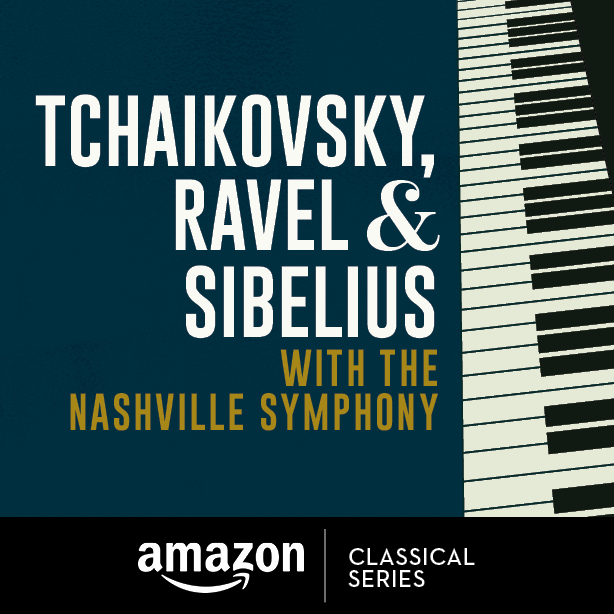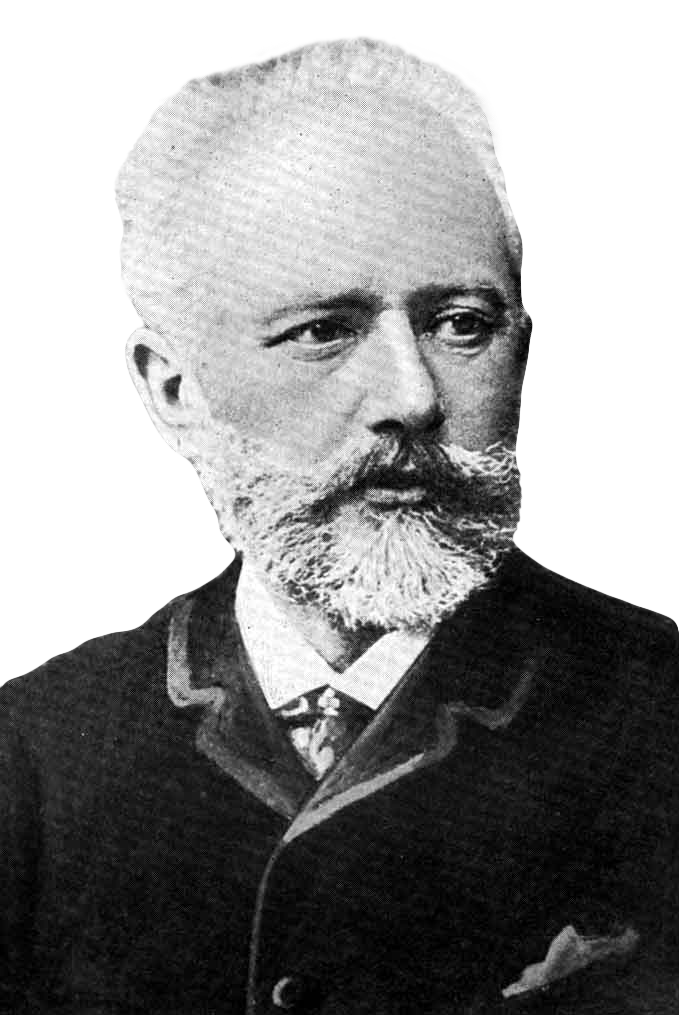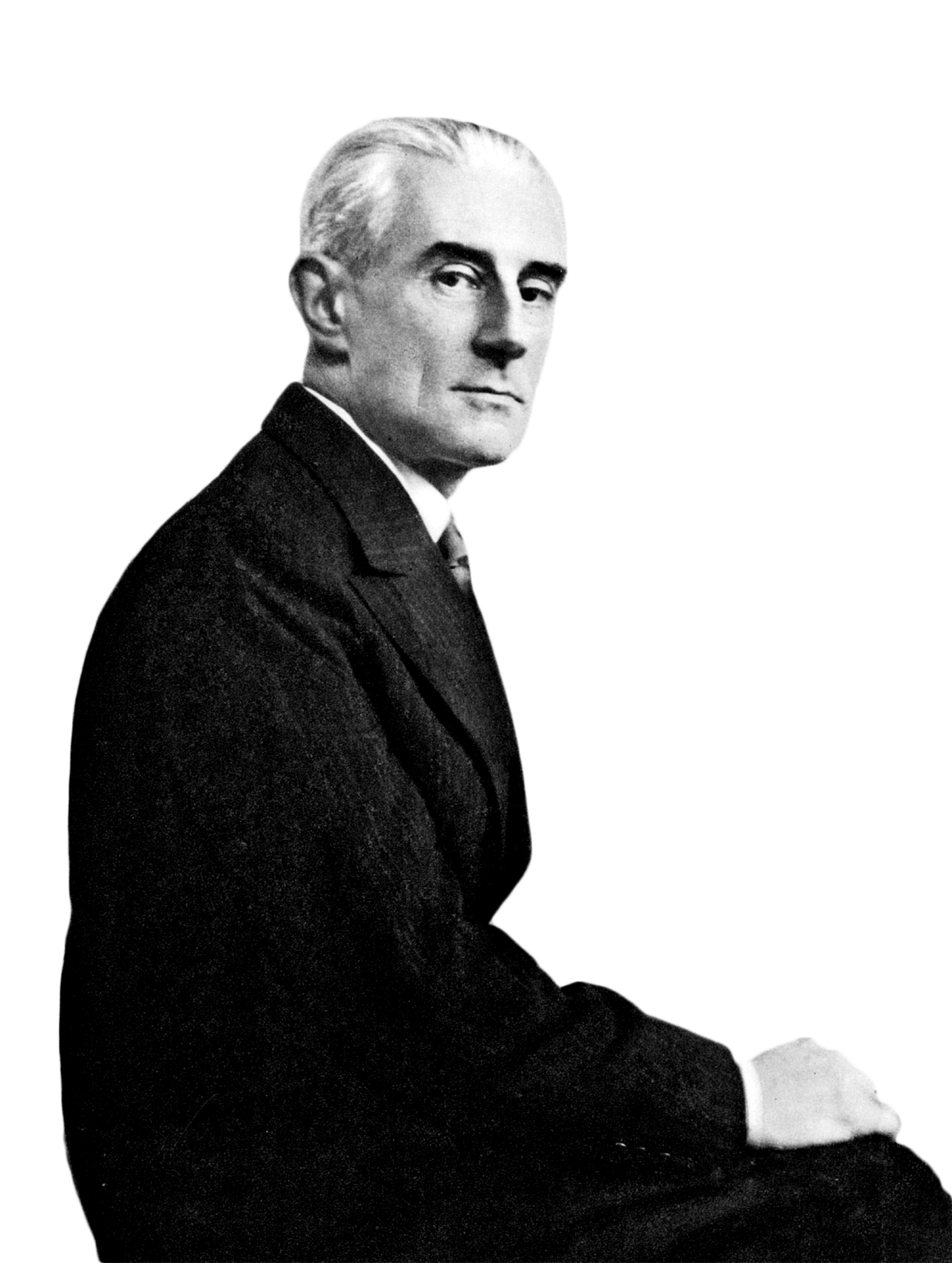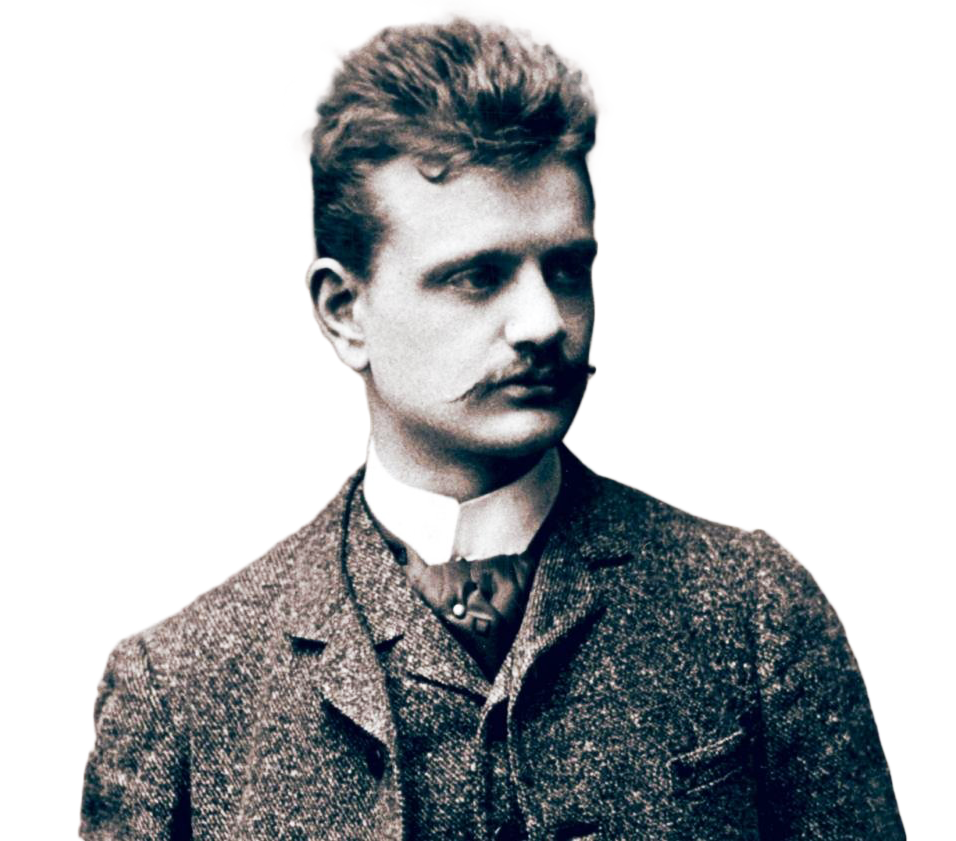
Our program begins with an early score by Tchaikovsky: his symphonic poem based on Shakespeare’s romance The Tempest. Shakespeare had inspired Tchaikovsky’s first breakthrough with his Romeo and Juliet Fantasy Overture, and in his treatment of The Tempest he similarly juxtaposes its central love story—between Miranda and Ferdinand—against the world in which the lovers find themselves, which in this case involves both the power and the serene beauty of nature.
Maurice Ravel’s Concerto in G, by contrast, comes from late in his career and amalgamates influences that fascinated the composer: the melody and emotional directness of Mozart, the sparkle of his fellow Frenchman Camille Saint-Saëns, and his new encounters with the jazz-inspired music of George Gershwin. While following the Classical concerto model, the music is quintessential Ravel, exquisitely orchestrated and abounding with witty and touching gestures alike.
Jean Sibelius, a Tchaikovsky enthusiast when he started out, also composed music inspired by Shakespeare’s Tempest (for a production at the Royal Theatre in Copenhagen in 1926). The Fifth Symphony, originally intended for his 50th-birthday celebration, also evokes the primal power of nature, though without any attendant program. The Fifth is the product of a pivotal period of transformation in which Sibelius came to terms with the lonely artistic path he had chosen to follow. Subjected to much revision, it emerged as a powerful credo that culminates in an instrumental hymn of joy—a musical expression of the epiphany Sibelius experienced one morning in nature when he observed a group of swans circling over him.
 |
|
|
|
|
|
|
|
|
|
|
|
|
|
|
|
Shakespeare was the impetus through which Tchaikovsky first found his true voice as a composer, via the “fantasy overture” based on Romeo and Juliet, composed in 1869. A few years later, he was to turn again to the playwright for another broadly sweeping orchestral work—this time, one modeled loosely on The Tempest. (He would also write music inspired by Hamlet much later in his career, in the late 1880s and early 1890s.) As with Romeo and Juliet, his imagination was sparked by selective elements within the play, while others are ignored wholesale. Tchaikovsky was drawn in particular to two aspects for musical evocation: the seascape surrounding Prospero’s island and the love that blossoms between Miranda and Ferdinand. Intermingled with these are portrayals of Ariel, Prospero, and Caliban. Structurally, the piece plays out as a freely associating fantasia.
The critic Vladimir Stassov, an artistic father figure to Tchaikovsky, suggested the following basic program as an outline for the composer: “The sea. Ariel, spirit of the air, raising a tempest at the bidding of the magician Prospero. Ferdinand’s ship sinks. The enchanted island. The first shy awakening of love between Miranda and Ferdinand. Ariel. Caliban. The young couple’s love grows to overwhelming passion. Prospero renounces his magic powers and quits the island. The sea.”
WHAT TO LISTEN FOR
A lengthy, slow introduction sets the scene with melancholy figures in the strings and far-ranging horn calls. Tchaikovsky’s placid sea shimmers with an almost Minimalist sheen. Ariel emerges with rapid flickerings in high winds. The music quickens into a glorious, chorale-like brass fanfare that signals Prospero’s majesty, as well as his power to summon the elements. Another aspect of the sea is heard as the timpani evoke the storm’s furious energy. Against surging strings, the brass splinter the horn call theme from the opening into pieces.
The love music occupies a good part of The Tempest’s content. As he had in Romeo and Juliet, Tchaikovsky initially presents a subdued version of this sprawling melody. A scherzo-like interlude interrupts the young lovers: a gossamer version of Ariel’s theme is juxtaposed with the clumsy music in low strings associated with Caliban. Later, the storm and shipwreck music is recalled. After an extravagant version of the love theme, a brass fanfare reasserts Prospero’s presence. But Tchaikovsky deflates his pomposity with a ghostly fade, suggesting the magician’s renunciation of magic, and returns to the sea’s lonely beauty—untouched by all the illusions that have transpired.
Scored for 2 flutes and piccolo, 2 oboes, 2 clarinets, 2 bassoons, 4 horns, 2 trumpets, 3 trombones, tuba, 3 timpani, cymbals, bass drum and strings
 |
|
|
|
|
|
|
|
|
|
|
|
|
|
|
|
In part a testament to the experiences Maurice Ravel acquired while touring the United States in 1928, the Piano Concerto in G ranks among the final masterpieces by the French composer. The piece draws on some efforts going back to 1914, when Ravel attempted to write a concerto-like piece that he was unable to finish. Initially, he planned to use the Concerto in G to showcase his own skills as a pianist, but another commission arrived from the pianist Paul Wittgenstein in the meantime and took precedence. The latter resulted in Ravel’s only other work in this genre, the Piano Concerto for the Left Hand (completed in 1930 and introduced in January 1932).
Ravel then turned his full attention to the Concerto in G, still intending it for his own use. But the deteriorating situation with his health by the time he finished the score in the fall of 1931 made him rethink that plan—as did the realization that his keyboard technique was not really adequate for the demands of the new score he had written. Ravel therefore asked his friend Marguerite Long, a champion of his music, to take over the soloist role, while he conducted the world premiere in Paris. He dedicated the score to Long, who also made the first recording and gave numerous performances of the piece. The Concerto in G (along with Boléro) was included on the program of the very last public performance that Ravel conducted, in November 1933.
While still under the impression that he would be premiering the work, Ravel wrote to a critic that it had been an “interesting experience” to plan two such very different concertos at the same time. “The one in which I shall appear as the performer,” he remarked, “is a concerto in the strictest sense of the word: I mean that it is very much written in the same spirit as the concertos of Mozart and Saint-Saëns. The music of a concerto should, in my opinion, be lighthearted and brilliant and not aim for profundity or dramatic effects.”
Ravel’s deep admiration for Mozart is especially evident in the Concerto in G, but so is his newfound fascination with music he discovered during his intensely crammed four-month tour of North America in 1928—the only time he saw the New World firsthand. Ravel tallied some 18,000 miles on this tour, both conducting and performing at the keyboard. One of the many stimulating discoveries was the music of George Gershwin, whom
Ravel met in March 1928 and who personally played his Rhapsody in Blue at a dinner party honoring the Frenchman on his 53rd birthday. Moments of Ravel’s score are moreover reminiscent of the American’s Concerto in F of 1925—though it should also be pointed out that Ravel remarked that his Concerto “has touches of jazz in it, but not many.”
Ravel was “enchanted” (his word) by Gershwin and his talent, and he advised Americans to pay attention to jazz as a serious art: “Personally, I find jazz most interesting: the rhythms, the way the melodies are handled, the melodies themselves,” he wrote. Gershwin asked about the possibility of studying with him, to which Ravel famously responded that he didn’t want to encourage him to write “bad Ravel” and lose his own spontaneous gift.
All of these influences—the classicism and melodic poignancy of Mozart, the sparkle of Saint-Saëns, the new inspiration from jazz—mix together in the Concerto in G, but always in ways that are unique to Ravel. By setting out to write what he called “a concerto in the strictest sense,” Ravel demonstrated his facility for wearing masks, seamlessly transitioning from one stylistic reference to another.
WHAT TO LISTEN FOR
Another influence on this music is the recollection of the innocent wonder of childhood: the first sound is the circus-like cracking of a whip. The opening theme from the piccolo, against a swirling harmonic haze projected from the keyboard, seems to mingle impressions that are art once timeless and modern. Ravel limits himself to a modest, chamber-size orchestra, yet with this he unleashes a kaleidoscopic range of colors and nuance.
The justly beloved Adagio assai slow movement is the music in which Ravel comes closest to Mozart (he referred specifically to “the Mozart of the Clarinet Quintet”). There isn’t any actual quotation: what is Mozart-like is the deceptive simplicity of the melody and accompaniment in the piano’s extended opening solo, as well the perfect timing of the woodwinds’ entrances. The circus whip returns in the brief final movement, along with a more vividly jazz-like sensibility. But amid the music’s headlong rush, fanfares, and march gestures, Ravel crafts each detail with care and unspoiled wonder.
In addition to solo piano, the score calls for piccolo, flute, oboe, English horn, 2 clarinets, E-flat clarinet, 2 bassoons, 2 horns, trumpet, trombone, timpani, percussion, harp and strings
 |
|
|
|
|
|
|
|
|
|
|
|
|
|
|
|
“Now it’s good. But, oh, this wrestling with God,” wrote Jean Sibelius during his protracted struggle to compose the Fifth Symphony. Although he had just returned from a highly successful American tour in June 1914, he would soon find himself cut off from the rest of Europe with the beginning of World War One. It was around this time that he plunged into serious work on the Symphony No. 5, intended as the centerpiece for his upcoming 50th-birthday gala in December 1915. (An event organized by the Finnish government, which treated its artists with enviable respect.)
Sibelius introduced the new symphony as a four-movement work at the gala concert on December 8, 1915, but was dissatisfied with the result. He revised the score over the next several years, arriving at the definitive three-movement version that he characterized as “more human … more down-to-earth, more vivid.” He conducted the Helsinki Philharmonic in its premiere on November 24, 1919.
Sibelius’s severely self-critical attitude is one he shared with Tchaikovsky, who had been a model earlier in his career. It might also help explain the Finnish composer’s failure to complete a rumored Eighth Symphony during the final decades of his long life, when he went silent. An element of creative doubt—and the accompanying urge to revise—played a significant role in the genesis of the Fifth Symphony.
Which is a tad ironic, since the Sibelius Fifth is often perceived as a work of triumphant self-confidence. The process of shaping it into its familiar final form involved many bouts of second guessing. Sibelius at one point even briefly considered radically amputating his third (already considerably pared down) version of the score and publishing only the first movement.
The long slog that eventually produced the Fifth as we know it began during a period of crisis. Sibelius spent the war years at his secluded home in the forests just north of Helsinki, though the violence of the Finnish Civil War between Reds and Whites (in parallel to the Russian Civil War) forced a brief exile in the city.
Being cut off from Europe while creating this work had a metaphorical significance for Sibelius: it underscored an increasing sense of isolation from the advances of musical Modernism in the past decade. Sibelius continued to grapple with essential questions about the validity of the Western tonal system and of the symphony as a genre. Although for much of the last century he was lambasted as a “reactionary” for not following the radical paths chosen by some of his contemporaries in response to this crisis, Sibelius has benefited from an enthusiastic reassessment in recent decades. Many music lovers admire this composer’s ability to evoke immense, lonely landscapes and a sense of mythic timelessness.
The Fifth Symphony has sometimes been assessed as a kind of counterpart to the “regressive” move Richard Strauss allegedly made in his opera Der Rosenkavalier (1911)—in the sense that both works could be said to return to a more accessible language after each composer had attempted their boldest musical experiments (with the Fourth Symphony and Elektra, respectively).
Yet as Sibelius remained driven by a determination to follow his own “interior journey”—a lonely path “that sought to uncover a deeply intuitive and nature-mystical relationship to sound itself through a process of meditative inwardness and ruthless self-criticism,” as the expert James Hepokoski observes. The “nature-mystical” dimension comes explicitly into play in an epiphany Sibelius recorded in his diary on April 21, 1915, while he was sketching out early ideas for the Fifth: “Today at ten to eleven I saw 16 swans. One of my greatest experiences! Lord God, that beauty! They circled over me for a long time. Disappeared into the solar haze like a gleaming, silver ribbon…The Fifth Symphony’s finale theme…That this should have happened to me, who have so long been the outsider.” The theme to which Sibelius refers—often tagged the “Swan Theme”—is the wheeling melody that emerges from the horns, like a hymn of joy, at the first climax of the final movement.
WHAT TO LISTEN FOR
With its sound world of horns, rolling timpani, and woodwinds, the opening is among the most memorable in the repertoire. This material evokes a sense of primal, emergent nature. Sibelius’s ideas seem to fluctuate unpredictably, even mysteriously, as more thematic ideas unfold. The first movement includes a section at accelerated tempo that reexamines the earlier ideas through the lens of a scherzo. The pace then speeds up even more for a final, frenzied outburst.
The middle movement presents a haunting set of variations on a deceptively simple five-note pattern (first heard on pizzicato strings and then played by a pair of flutes). A restless whirlwind opens the final, setting the stage for the Swan Theme to emerge, which in turn becomes accompaniment for an expressive countermelody sung above by woodwinds.
But this is still not the goal of the Fifth. A development-like section varies all of these ideas, yet in lieu of a straightforward recapitulation, Sibelius slows the tempo and thickens the orchestral texture. The Swan Theme, further intensified, at last seems to give definite form to those enigmatic calls from the beginning of this journey. Between the strokes of the six hefty chords that conclude the work, Sibelius interpolates strategic silences that reverberate with shattering power.
Scored for pairs of flutes, oboes, clarinets, and bassoons; 4 horns; 3 trumpets; 3 trombones; timpani; and strings.
